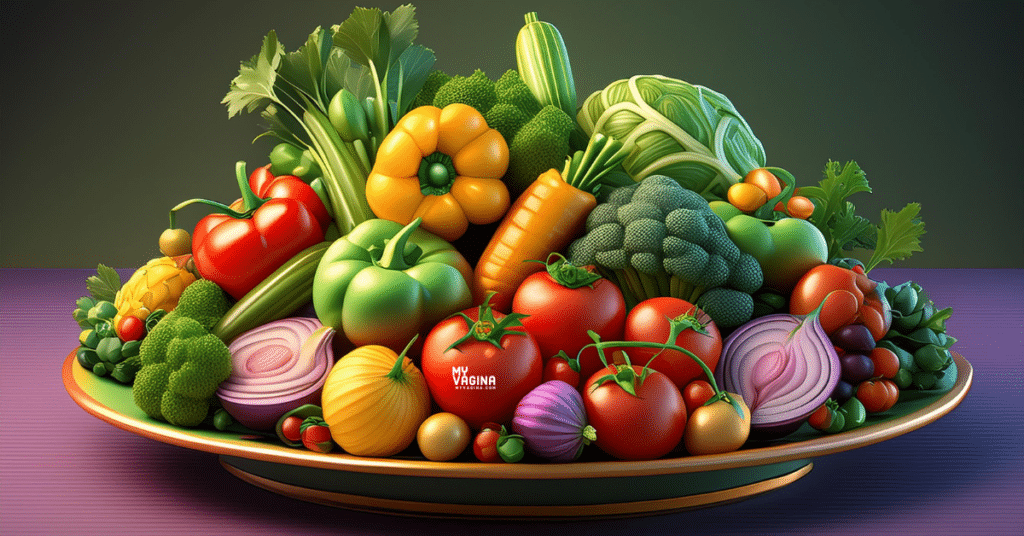For years, it has been widely understood that increasing the intake of plants, particularly fruits and vegetables, is essential for maintaining good health and longevity.
When vegetables come to the rescue: resolving vagina problems
Making sure you’re getting all your nutrients is particularly important when working to heal your body from vulvovaginal, urinary tract and other health problems. Diet matters.
Numerous studies have shown that diets rich in plants are key to preventing chronic diseases, but we also know that vaginal infections like bacterial vaginosis1–3, skin problems4,5 and other problems can be closely related to nutrient deficiencies and food intolerances.
Certain genetic mutations may make you more susceptible to nutrient dysregulation, such as folate and iron. Eating more vegetables and improving the overall diet can improve symptoms drastically without medications or treatments.
How many vegetables should I be eating?
It is recommended to consume at least 2 pieces of fruit and 7 different vegetables daily. However, many of us find it challenging to reach the goal of 7 vegetables a day.
Vegetables are not only nutritious but also delicious! Here are 9 tips to help incorporate more plants into daily meals.
Tip 1: Make vegetables the main event
Traditionally, meals often feature ‘meat and three vegetables’ with the meat being the main focus and the boiled or steamed vegetables sitting unappealingly on the side. Consider switching this around by making vegetables the main attraction, with a side of protein if desired.
In many households, plant-based recipes are now the main course, with fish, seafood, beef, lamb, or eggs as an accompaniment to the vegetables. This shift has brought excitement to the way vegetables are enjoyed. Yotam Ottolenghi is a favourite source for vegetable recipes, along with Green Kitchen Stories.
Tip 2: Try different (tastier) cooking methods
Disliking the taste of zucchini, Brussels sprouts, fennel, mushrooms, or beetroot might change if they are cooked differently. The method of cooking can alter the flavour, and pairing them with other ingredients can also affect the taste.
Consider the flavour of asparagus grilled on the BBQ or roasted Brussels sprouts and parsnips with lamb. Grating beetroot or fennel into a salad or coleslaw can also enhance their taste.
Adding herbs to cooking can bring out the best in vegetables. Some excellent flavour combinations include mushrooms with rosemary, tomatoes with thyme, butternut squash with sage, mint with cucumber, caraway seeds with cabbage, and dill with potatoes.
Tip 3: Make slow changes
Gradually increasing the quantities of vegetables consumed makes the transition easier and less noticeable, especially for children.
Start by adding an extra salad or vegetable dish to weekly meals. Preparing a large salad ensures leftovers for the next day. Each week, try a new vegetable by baking, steaming, or adding it to a salad.
Buying a few extra pieces of fruit for the fruit bowl each week is another strategy. If the extra fruit isn’t eaten by week’s end, it can be stewed, poached, or added to smoothies.
Tip 4: Plan and meal prep
Vegetables rotting in the fridge due to lack of time or inspiration can be discouraging. Planning meals before shopping for fruits and vegetables can prevent this waste.
Tip 5: Meat-Free Mondays
Dedicating Mondays to eating only plant-based foods and proteins, such as lentil soups, cauliflower soup, black bean salad, frittatas, or bean tacos, can increase plant consumption.
There are many resources available for those interested in Meat-Free Mondays.
Tip 6: Swap meat for beans
Vegetarian versions of popular family meals can boost plant-based food intake. Meals that work well with plant proteins include tacos, lasagna, and other Italian dishes.
Tip 7: Try breakfast fruits and vegetables
Starting the day with fruit and encouraging family members to do the same can be beneficial. Berries and soft fruits can be added to oats, muesli, or smoothies.
Breakfast is also an excellent time to incorporate vegetables. Eggs pair well with baby spinach, sautéed mushrooms, tomatoes, and fresh herbs. Vegetables can be served alongside poached eggs or mixed into an omelette or frittata.
Tip 8: Increase variety of fruits and veggies
For those who already consume many vegetables, the next step is to increase the variety. Studies have shown6 that a diverse range of fruits and vegetables can lead to a more diverse and healthy gut microbiome. Aiming for 30 different vegetables in a week is a good goal.
Try to include vegetables from different plant families. Think about how they grow: underground (carrots, parsnips, beetroot), as fruit (tomatoes, eggplant, capsicum), flowers (broccoli, cauliflower, artichoke), pods (peas and beans), bulbs (onion, fennel), spreading plants (pumpkins, zucchini), salad vegetables (mustards, lettuce, spinach), stems (asparagus, celery), and herbs and sprouts.
Tip 9: Get support – we can help!
For those struggling to eat more vegetables, unsure about which ones are the healthiest, or experiencing digestive issues with vegetables, booking a consultation can be beneficial.
Nutrition advice can pave the way for a lifetime of good health and disease prevention, particularly for those with a genetic predisposition to chronic diseases such as diabetes, arthritis, osteoporosis, and cancer.
The hope is that everyone will soon love eating their vegetables as much as we do!
References
- 1.Parsapure R, Rahimiforushani A, Majlessi F, Montazeri A, Sadeghi R, Garmarudi G. Impact of Health-Promoting Educational Intervention on Lifestyle (Nutrition Behaviors, Physical Activity and Mental Health) Related to Vaginal Health Among Reproductive-Aged Women With Vaginitis. Iran Red Crescent Med J. Published online August 8, 2016. doi:10.5812/ircmj.37698
- 2.Noormohammadi M, Eslamian G, Kazemi SN, Rashidkhani B. Association between dietary patterns and bacterial vaginosis: a case–control study. Sci Rep. Published online July 16, 2022. doi:10.1038/s41598-022-16505-8
- 3.Shivakoti R, Tuddenham S, Caulfield LE, et al. Dietary macronutrient intake and molecular-bacterial vaginosis: Role of fiber. Clinical Nutrition. Published online October 2020:3066-3071. doi:10.1016/j.clnu.2020.01.011
- 4.Katta R, Schlichte M. Diet and dermatitis: food triggers. J Clin Aesthet Dermatol. 2014;7(3):30-36. https://www.ncbi.nlm.nih.gov/pubmed/24688624
- 5.Lim JJ, Lim YYE, Ng JY, et al. Burgers, Fast Foods, and Increased Associated Risk for Atopic Dermatitis: A Cross-Sectional Study of Dietary Habits among Young Chinese Adults in Singapore/Malaysia. Dermatology. Published online September 4, 2023:77-84. doi:10.1159/000533942
- 6.Kazemi A, Golzarand M, Shojaei-Zarghani S, Babajafari S, Mirmiran P, Azizi F. Is variety more important than quantity of fruits and vegetables in relation to cardiovascular disease incidence and mortality? Results from a prospective cohort study. International Journal of Food Sciences and Nutrition. Published online January 22, 2024:306-316. doi:10.1080/09637486.2024.2304134





